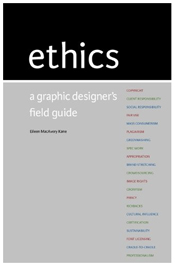I met Eileen MacAvery Kane, a New York professor of graphic design, through her excellent blog on Ethics In Graphic Design. I was so impressed with her ideas that I invited her to guest blog with us this month on morality and design. Take it away, Eileen…
When I first began researching for my thesis on the topic of ethics in graphic design I asked graphic practitioners and educators what they felt the most important issue is.
Everything from crowdsourcing to plagiarism to kick-backs to social responsibility was mentioned. When asked to give personal stories about their encounters with ethics in graphic design, the answers were as numerous and diverse.
In graphic design a search for ethics often turns up resources for best practices and business ethics. People tend to think legal issues can be separated from moral issues and dealt with independently. In a recent class I taught on brand identity, my students were surprised, and a few of them a bit horrified, at the daunting complexities involved in securing copyright, font licensing, and trademark.
As they dove in and discussed the implications of and differences between them, the conversation soon turned to issues of integrity. Cases like Shepard Fairey’s Obama Hope poster and Richard Prince’s Canal Zone came up. Other examples like John Williamsand Logo Garden were also raised.
Students were surprised to see that in some cases modifying artwork may be legal, but at the same time morally reprehensible.
The topic that I find to be the most interesting when discussing ethics in graphic design is what good design means. Is good design socially responsible, eco-friendly, or as Thomas Watson said, good business?
Many think good design is synonymous with making things look good—design that wins design awards.
One of the dictionary definitions of good is “morally excellent.” This leads graphic designers to a conundrum. While every profession must deal with ethics in its particular field, graphic designers are trained to make things look good.
In “12 Steps on The Road to Hell,” Milton Glaser asks designers a series of questions about what they have done in their career to make things look good—each more progressively objectionable.
He attests to the fact that he personally has taken a number of them. This leads me to ask, does graphic design require a certain moral flexibility?
Historically, graphic design has been an agent of moral and ethical thought. From the Code of Hammurabi to to the broadsheets used to spread the word of Martin Luther, graphic design has been used to visually communicate beliefs and ideas—to inform, inspire, and delight.
During the Middle Ages campaigns like Ars moriendi were designed specifically to influence the behavior of individuals, in this case urging those on their deathbed from the bubonic plague to leave their money to the church.
The approach may be gentler, but one may wonder how much different present day campaigns are that ask their patrons to consider adding them to their will.
Although full of its own controversy about the integrity and ethics of its founder, David discusses that despite being the most rapidly viral social justice campaign in human history with over 98 million views to date, there still has been no arrest of Joseph Kony as we near the end of 2013.
Messaging alone cannot save the world, but design is a powerful tool that can be used to help. It’s up to each graphic designer to decide what road they choose to travel down.
Our guest blogger, Eileen MacAvery Kane is a graphic designer, educator, and author of “Ethics: A Graphic Designer’s Field Guide” and the blog “Ethics in Graphic Design.” Learn more atethicsingraphicdesign.org.
Reviewed December 4, 2013

I so appreciate your advocacy for ‘good’ graphic design. Thank you!
You are so welcome. And from an Eichler too! We like Eichlers. 🙂